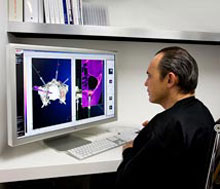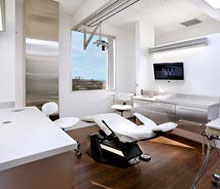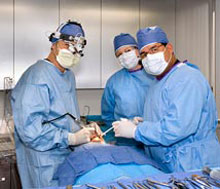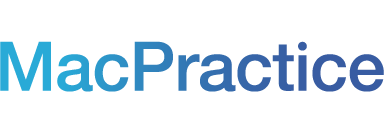Happy Clients
Peter S. Wohrle, DMD
Implant Practice US talks to Dr Peter S. Wohrle about his Life, Practice and Profession
Implant Practice US: Can you tell me about your background?
Dr. Wohrle: I was born and raised in Germany, graduated with an AB in Humanities, one-year studies at European Business School, and completed a four-year program as Certified dental laboratory technician in Switzerland.
I also attended Harvard School of Dental Medicine at DMD cum laude, achieving the Advanced Education Program in Prosthodontics, Advanced Education Program in Implant Dentistry and Master of Medical Sciences in Oral Biology.
IPUS: When did you decide to become a specialist and why?
Dr. W: While attending the Harvard School of Dental Medicine, the School founded the first Department of Implant Dentistry at a nearby US Dental School. To enroll, one had to complete first a specialty program in Prosthetic Dentistry. The Chairman of the Department, Dr Paul Schnitman, became my mentor during my undergraduate studies, and I spent all my extra time there. I decided to pursue the double degree program, first in Prosthodontics, then Implant Dentistry. I became the first student to enroll and graduate from the program. Since then, all my activities have focused on Implant Dentistry
IPUS: Is your practice solely Implant Dentistry or do you practice other types of dentistry?
Dr. W: Wohrle Dental Implant Clinics focuses on the diagnosis, treatment planning, insertion, restoration and maintenance of dental implants. However, all facets of dentistry are provided within one convenient setting, with other well- qualified doctors providing various aspects of treatment. Dr. W. himself focuses exclusively on implant dentistry. However, larger cases requiring traditional prosthetic intervention, like full mouth reconstructions on both implants and natural teeth, are also performed by him.
IPUS: Do your implant patients come from referrals?
Dr. W: Yes from other patients. Initially when I started the practice more than 18 years ago, I was placing the implants for restorative dentists. However, when the patients later returned for follow-up, I was sometimes puzzled on what happened; therefore, I decided to retreat from the referral model and offer the entire range of implant dentistry the total solutions provider which enabled me to have complete control of the entire case. I practice this approach now for over 15 years, and it has been very rewarding. However, the local dental community sees me as a 'super dentist', which does not fit the traditional referral system. Referrals from them are typically difficult cases, which have had their fair share of problems.
IPUS: How long have you been performing Implant Dentistry and what systems do you use?
Dr. W: I have been placing implants now for over 20 years. I have been trained on all major systems while undergoing my specialty training in implant dentistry which was one of the many requirements. I know all major implant systems 'inside-out', and we stock many of the components of the major systems as we treat many patients who have had either old implants that are in need of new restorations, or that come from either other Doctors or even foreign countries to have the reconstructions finished. When I am starting a case, we use exclusively Nobel Biocare products. Nobel Biocare is the worldwide leader in implant dentistry, and has the best scientific evidence for long-term success and follow-up. In addition, most of the innovative, cutting edge technology that is developed in implant dentistry today is brought to the market by Nobel Biocare.
IPUS: Can you tell me more about the training you have undertaken?
Dr. W: I have completed a full postdoctoral program in prosthodontics (specialty of replacing missing teeth / tooth structure), followed by another full-time 3 year postdoctoral program in Implant Dentistry, both at Harvard University, which focused on the surgical aspects. In addition, I hold a Master of Medical Sciences degree in Oral Biology. Oral Biology is the basis for successful implant dentistry, understanding the interactions that occur around an implant after insertion, maturation and loading are essential for long-term success. In addition, I am a certified dental technician from Switzerland, having completed a four-year full time program relating to the design and fabrication of dental prostheses. Most implants in the US are placed in a 'team' setting, where a surgeon, restorative dentist and technician closely collaborate. I do the same thing I work as a team, it just happens that I am the surgeon, restorative dentist and technician all in one person. This gives me, as some of my colleagues say, an unfair advantage I know what areas are involved, and I know exactly where the treatment is headed.
In addition, I have placed and restored dental implants for close to 20 years exclusively, on a full-time basis. This leads to tremendous experience, which most other doctors involved in implant dentistry don't achieve in their entire career because implants are one of many areas of interest and expertise. I am proud to say that I am one of a few dentists worldwide that have formal training in the interrelating areas of implant surgery, inplant prosthodontics, and implant laboratory technology.
IPUS: Who has inspired you?
Dr. W: There are many people that inspired me. Professionally my mentors that I was fortunate enough to work with include Paul Schnitman, Stephen Campbell and Doug Atwood, all Harvard Professors. They had not only tremendous knowledge and love for teaching, but their commitment to excellence was demonstrated in their daily work. In art and architecture, the Bauhaus era with their vision of simplicity, clean lines, eliminat ing the unnecessary, all these are concepts that are directly applicable to my professional life.
IPUS: What is the most satisfying aspect of your practice?
Dr. W: Clearly the interactions with patients. Helping them to achieve their best, how they feel about themselves is the ultimate reward. Seeing the difference in the quality of our patient's life is certainly the most gratifying aspect in any patient- doctor relationship.
IPUS: Professionally, what are you most proud of?
Dr. W: Staying the course of delivering the best possible care, even when no one else but me could see that there might be a problem. Professional honesty, pursuit of excellence and being obsessive compulsive about details are some of my trademarks. Profesionally, I was involved in the original research on immediate loading of endosseous implants headed by Dr. Paul Schnitman. Having applied these principles for the past 20 years, I feel very confident to exercise the clinical judgment necessary when doing these procedures. In addition, various other techniques have evolved from this original research, such as the immediate tooth replacement, which I first presented to the dental community in the mid-1990's. In addition, I have a keen research interest in the relationship between hardware components and esthetic outcome, which culminated in the development of the scalloped implant which was introduced worldwide in 2003. Currently, we continue working on these principles to further improve patient satisfaction.
IPUS: What do you think is unique about your practice?
Dr. W: There are so many unique things. My education. My approach to the patient's problems, where I don't use a prefabricated approach to treatment, but developing treatment plans that fit the patient, addresses their needs, and takes their value judgment into consideration. Ultimately, the patient will decide which treatment is best for them; my job is rather to guide them, give them the statistical probabilities in achieving success, but we don't treat every patient with the same problem the same, as they all have different needs, expectations and financial restraints. Experience. After placing and restoring implants for 20 years on a full-time basis, few surprises remain. Control. Since we deliver all aspects of care, finances, outcome, time estimates all are well controlled and predictable.
IPUS: What has been your biggest challenge?
Dr. W: Initially it was building a total solution provider setting which didn't fit the traditional referral patterns. Meanwhile the hard work has paid off, where patients and some dentists alike refer for treatment outcome and patient experience. Today, the biggest challenge remains providing excellent care with the best materials and treatment approaches at an affordable fee, a concept I have been working on for a long time. We have made great progress in the totally edentulous patient; now we need to transfer that knowledge and techniques to the partially edentulous.
IPUS: What would you have been if you didn't become a dentist?
Dr. W: That's an interesting question. I can envision myself as an architect, building, creating things. Esthetics, outcome, quality of life, helping people feel better in their own environment. Dentistry and architecture are not that far apart, it requires the same thought process, love for attention to detail, perception how something should look like, and working towards achieving that goal.
IPUS: What is the future of Implant Dentistry?
Dr. W: The future is very bright but the provider model will change in the near future. Today, the US is the only major market in the world where care is provided by numerous doctors that work together as a team, each in their own offices. Compared to other countries, the costs are higher, the treatment takes longer and the patients are inconvenienced more. In many cases, outcome is not necessarily better. Hence I predict that in the future implant centers will blossom the Total Solutions Provider model. That doesn't necessarily mean one doctor that provides the entire treatment, but rather one center that is staffed adequately for complete implant care, from diagnosis and treatment planning to surgery, to restorative dentistry, all with adequate laboratory support on the premises. In addition to gaining more experience, cost will come down just by an increased in efficiency and proficiency, and outcome in terms of quality of survival will improve.
IPUS: What are your top tips in maintaining a successful implant practice and what advice would you give to budding implant dentists?
Dr. W: Maintaining a successful implant practice is entirely dependent upon the perception of your patients. Were their expectations met, did the doctor address their need, and could he deliver? If the answer is yes, these patients will refer new patients. If patients had a posi tive experience with no 'surprises', they will send their friends. On the other hand, patients that were disappointed with their outcome, whose expectations were not met, will let their friends know as well. For new colleagues, the most important advice I can give is to provide the services that you are comfortable and competent in. Patients sense immediately if you have done 100's of cases, or if you are just starting. Stay within your comfort zone, and expand the zone with experience. We all had to start some where. Also, to become profitable in Implant Dentistry, the patient volume should reach a minimum of 20% of the total practice volume. Then not only the Dr, but the staff as well has adequate proficiency to deliver exceptional outcomes on a regular basis, and the overhead expenses that come along with providing these services is justified.
IPUS: What are your hobbies and what do you do in your spare time?
Luckily, my profession is my hobby. If I don't treat patients I lecture, work on articles and think about new ways of solving problems. I meet constantly with professional friends throughout the world to exchange ideas and to make things work even better. And of course I spend time with my family, my wife and my two daughters.
Wohrle Dental Implant Clinic
Peter S. Wohrle, DMD, MMedSc, CDT (CH)
Clinical Director, Wohrle dental implant clinics
Wohrle Dental Implant Clinic, Newport Beach, CA
The Wohrle Dental Implant Clinic delivers
unprecedented patient care and convenience
by offering all aspects of implant therapy in
one cutting edge facility. While typical implant
dentistry involves patients traveling back and
forth between specialty and/or general practice
offices, The Wohrle Clinics are staffed by
doctors encompassing skills in implant surgery,
implant prosthodontics and implant laboratory
technology. Additionally, the Wohrle Dental
Implant Clinic comprises a state-of-the-art office
with CAT scanning and computer guided surgical
technology onsite. Minimally invasive techniques,
based on computer guided surgery, are routinely
performed for better outcome and patient
comfort.
Favorite products and equipment used in our practice
iCAT
The volumetric images obtained by the iCAT are
high-resolution, three-dimensional views of the
patient's anatomy. In the Clinic, low radiation
and fast turnover are extremely important
for a routine application prior to any implant
placement. From initial scan to discussing
treatment options with the patient typically takes
less than 2 minutes. At that point, I present the
findings to the patient and present different
treatment options with confidence. Critical
information such as available osseous height and
width, proximity to vital structures and adjacent
teeth and potential need for grafting procedures
are easily visualized by experienced users. In
addition, the data collected will be used later
for the virtual surgery within the NobelGuide
software.
NobelGuide and Procera
Using NobelGuide enables me to diagnose and
treatment plan every patient in a most efficient
and predictable way. Once diagnostic appliances
have been fabricated, the CAT-scan is used to
place the implants in a virtual environment.
Based on this information, a surgical template is
fabricated, which transfers the virtual planning
exactly to the patient's anatomy, and implants can
be delivered precisely, when indicated in a flapless
approach. Simultaneously, interims restorations
can be prefabricated and placed at the time of
implant installation.
Once soft- and hard tissue remodeling has occurred, final impressions are taken. Restorations are completed using the Procera system, in either zirconia, alumina, or titanium, depending upon the patient's needs and desires. Studies have shown that the marginal fit and strength of these restorations is superior to anything else on the market; in addition, the aesthetic outcome satisfies even the most critical patient.
MacPractice / Apple Computers
I have been a Mac aficionado since the
introduction of the first Apple Macintosh. In a
dental practice, it was hard to incorporate the
Mac as most of the software was designed
to run on PCs. We had a split system, PC for
office administrative aspects, Macs for patient
education, slide collection and organization,
and for the preparation of lectures. Of course,
any videos we took were handled on the Mac
side as well. Then we switched our office
administration software to MacPrcatice DDS,
which was developed specifically for Mac OS
X. Since then, we have eliminated most of our
PCs, and most of the problems have gone away
along with the PCs. All operatories, surgical
suites, the treatment plan room, the front and
back offices, all have their own Apple computers,
and all share the same network. The support we
receive from MacPractice is outstanding, and
new developments keep on coming, like the
iPhone interface, allowing me to check either the
schedule, patient records or anything else that is
documented in the system from any place in the
world. The biggest advantage of using this system
is the user friendliness that Macs are known for.
With minimal training, motivated staff members
can learn the intricacies of the system within a
very short time.
Magnification in dentistry is an absolute must the first step in quality control. Since the beginning of my training in dentistry I am used to work with magnification, either at the bench or in the operatory. The right combination of comfortable glasses with adequate magnification and depth of field is hard to find among the many manufacturers. In addition, a headlight is needed in most cases where direct overhead light is either blocked or not in the same long axis. Using the most advanced combination of loupes and headlight, the Heine 3S unplugged, has made it easier for me to routinely see better, and thus being able to deliver better quality of care to my patients, all without any cable hanging off my back.



